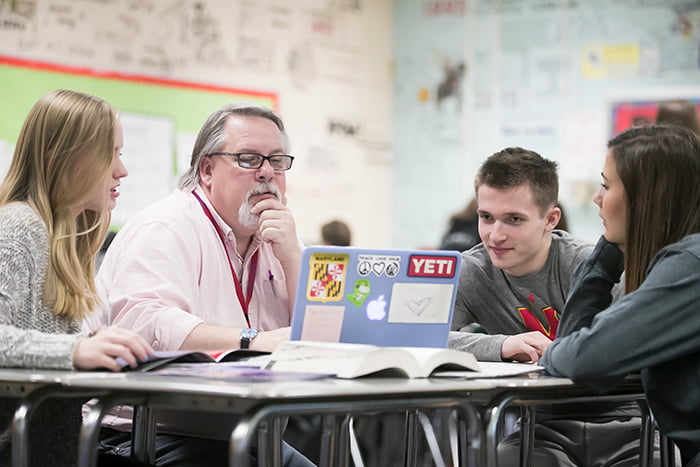Guest Voices: High School Journalism Preserves Profession’s Integrity
April 30th, 2019

Rus VanWestervelt, journalism advisor and English teacher at Centennial High School, is the author of several fiction and non-fiction works and has written for local and national news organizations for the last 25 years. He began teaching high school journalism in 1987, joining HCPSS in early 2003, and is the founder and advisor of Maryland Voices, a creative nonfiction publication for high school writers statewide.
Twenty-five years ago, as one senior editor pressed her thumb against the toggle switch on the light table, dimming the room temporarily, another senior editor fired up the brand new Macintosh and waited for PageMaker, the “industry standard for desktop publishing,” to come alive.
“This changes everything,” the first editor whispered, in a reverent tone.
The other, now logging his credentials into the computer, nodded as the drafted design of their newspaper appeared on the tiny screen.
“Find me the floppy with Heather’s article on it,” he said, already forgetting the significance of the switch. “I want to see if it fits.”
In the early 1990s, when we were all abandoning our light tables and embracing desktop publishing, we thought that journalism was entering a new era, and it was. With digital publishing, we were offered the opportunity to print “breaking news” from our school printers, and we did it often.
About 10 years later, the students on Centennial’s newspaper team, The Wingspan, faced a new frontier in online publishing. With it came the real “fake news” of stories being pushed before they were fully vetted. The goal in that early era of online publishing’s “wild, wild west” was Be The First, Even If It’s The Worst.

We never embraced that attitude in the classroom, and we were fortunate in a pedagogical setting to stick close to our ethics; our foundation of solid reporting to tell the truth with integrity never waivered. Even when newspapers across the country were abandoning their print editions and we were told that “journalism is dead,” we persevered in the classroom and evolved with our target audience: our students, staff, administrators and parents.
At Centennial, we built our online program in the same way that we established our print team in the 1980s. Our online articles would be given the same treatment as what went into print. We were persistent, relentless and continued to build print’s runty little sibling every single day by publishing breaking news, club events and sports results as they happened.
As well, in 2012 we moved to a full-color news magazine format that focused on longer in-depth features. By 2017, both print and online platforms were getting equal but unique traffic.
The tone of our publications room is no different than any other newsroom you will find for local, state or national papers. There is an air of integrity, a firm responsibility that the legacy left by previous journalists means something, to them as individuals and to the greater profession of journalism. It matters to put your words into print, either digitally or in a magazine; every byline says to the world, “My name is a stamp of integrity that I do not take lightly.”
Today’s high school newsroom is quite different than when we crowded around that one Macintosh computer and whispered edits over the tense shoulders of a focused editor. Our 17 Macs are in use daily, and our students have fine-tuned this very balanced machine that uses both print and online to share, document and archive the history of our school. Today, we are pushing on to the next frontier: multimedia journalism. We will build this platform over the next five years as we constructed our online team.
This is certain: In the community we serve, journalism is thriving, and the number of our graduates entering the field of journalism, communications and graphic design continues to rise.
There is nothing fake, dead or antiquated about what our students do daily in their commitment to publish all the news that’s “fit to print.” If we are to move above and beyond the challenges the field of journalism faces today, then we must educate and prepare our student journalists to be uncompromising to the principles that define unembellished, accurate journalism. Our student journalists, photographers, editors, designers and business managers understand and embrace the power of the pen and of the image; it is their confidence that will strengthen the integrity of this profession well into the depths of the 21st century.
 HCPSS
HCPSS